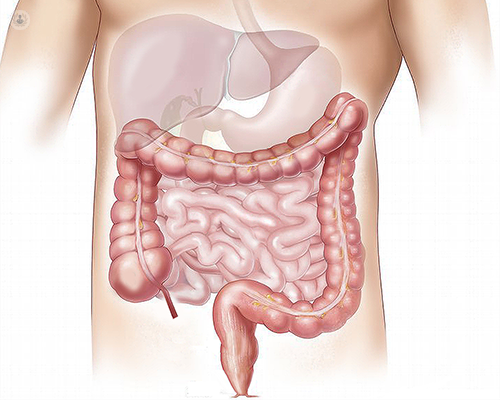Colonoscopy, polyps and other colon examination methods
Escrito por:A colonoscopy is a common medical procedure that enables your surgeon to examine the inner lining of the colon and rectum using a flexible tube equipped with a camera.
This article provides an expert insight into the reasons for undergoing a colonoscopy, how colon abnormalities are managed, and what are some alternative colon examination methods.

When is a colonoscopy recommended?
A colonoscopy is performed for various reasons, such as:
- To screen for colorectal cancer.
- To investigate symptoms, such as rectal bleeding, abdominal pain, chronic diarrhoea and unexplained weight loss.
- To detect and remove polyps.
- To monitor chronic conditions, such as inflammatory bowel disease (IBD).
If found, how are colon abnormalities (like polyps) managed?
Polyps are one of the most common discoveries during a colonoscopy. If found, your surgeon will remove them using specialised tools through a minimally invasive procedure known as a polypectomy, which involves snaring the polyp and excising it.
Larger or more complex polyps may require additional procedures, such as endoscopic mucosal resection or surgery. Once removed, your surgeon will send the polyps to a laboratory for histopathological analysis.
In cases where cancerous or precancerous cells are detected, further management may include surgery, chemotherapy, radiation, or a combination of these treatments, depending on the stage and severity of the condition.
Are all polyps harmful?
Not all polyps are harmful. For example, hyperplastic polyps generally carry little to no risk of developing into cancer, while adenomas and sessile serrated polyps carry a higher risk of malignancy, especially if they are large, multiple, or found in certain parts of the colon.
Regular surveillance through a colonoscopy is essential, as this can detect precancerous polyps and prevent the progression to colorectal cancer.
What are alternatives to a colonoscopy?
While a colonoscopy is considered the gold standard for colorectal examinations, several methods are available for those unable to undergo the procedure, including:
- Flexible sigmoidoscopy: This procedure examines the lower part of the colon, specifically the rectum and sigmoid colon.
- CT colonography: Also called a virtual colonoscopy, this non-invasive imaging test uses a CT scan to create detailed images of the colon and rectum.
- Stool-based tests: These include the faecal immunochemical test (FIT), guaiac-based faecal occult blood test (gFOBT), and stool DNA tests. These tests detect blood or DNA markers.
- Capsule endoscopy: In this procedure, a small capsule equipped with a camera is swallowed, capturing images as it passes through the gastrointestinal tract.
The choice of examination will depend on your individual health needs, preferences, and the advice of your surgeon.
How often should people with a history of colon abnormalities undergo a colon examination?
The frequency depends on several factors, including your individual risk factors and the findings of previous examinations.
- People with one or two small adenomas (less than 1cm) require a follow-up colonoscopy within 5-10 years.
- People with larger polyps, multiple adenomas, or sessile serrated polyps require a follow-up colonoscopy within 3 years.
- People with more advanced conditions, such as previously treated colorectal cancer or genetic syndromes, require a follow-up colonoscopy annually or biennially.
People with a family history of colorectal cancer require a colonoscopy every 10 years starting at age 45 or earlier, in some cases.
Consulting with your surgeon about the most suitable screening method and adhering to recommended intervals can reduce the risk of colorectal cancer and other colon-related conditions.


